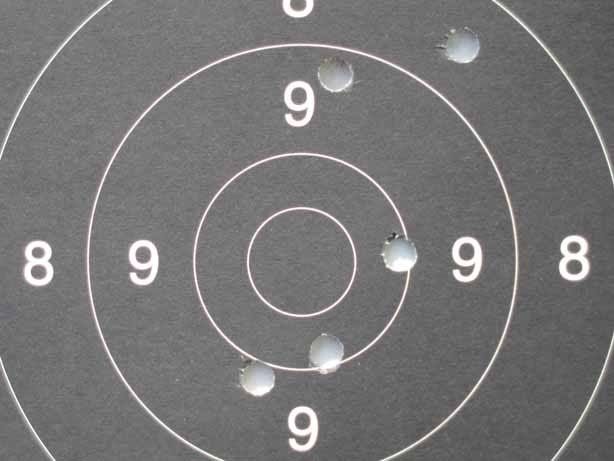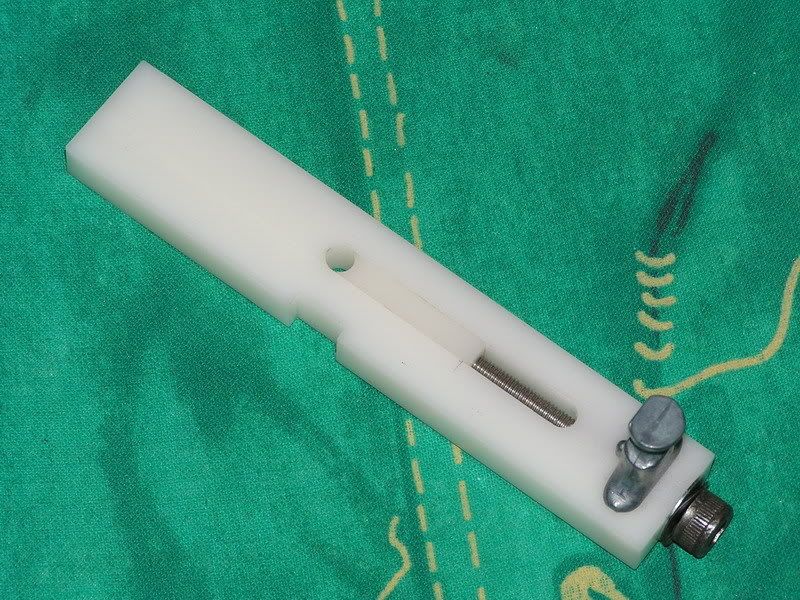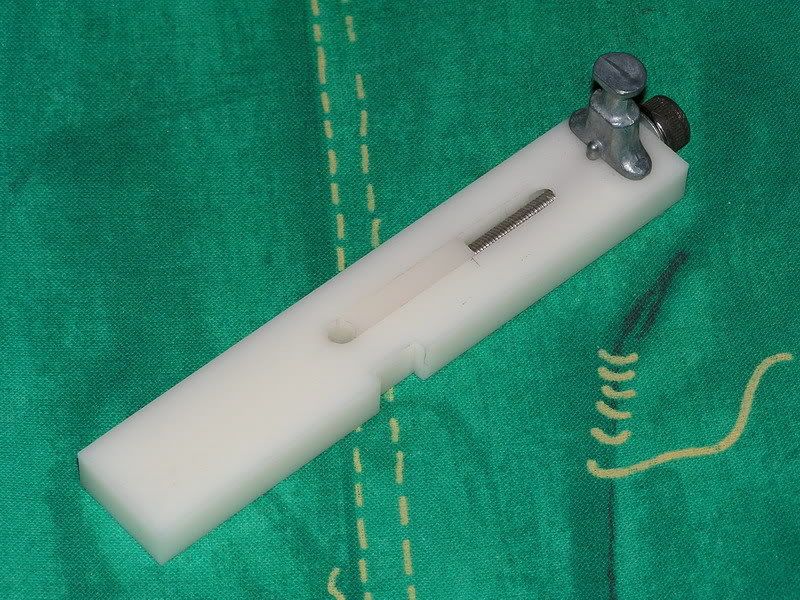Page 1 of 3
.32" S&W reloads
Posted: Tue Mar 13, 2007 8:17 am
by Axel
Hello!
Why is it so that my own reloads does not produce the perfect round holes that factory ammunition does? Not round holes is a sign of bullet instabillity in the air - I do not like that! :-(
Here is some technical info about my reloads:
- 1.5 grains Vihtavouri N310. This load speeds up the bullet to around 240 meters/sec (exactly the same speed as with Lapua/Norma factory loads)
- 98 grain Lapua bullet (exactly the same as Lapua/Norma factory loads)
- CCI smal pistol primer (tried Federal 100 before, no difference)
Factory ammunition is Norma 98 grains (which is the same as Lapua)
Please look at the following pictures. Targets has been shot from 25 meters, about 27 yards with a Pardini HP pistol.
Factory ammunition:

Own reloads:

Please give me some input about this!
Cheers,
Axel
Posted: Tue Mar 13, 2007 8:25 am
by Richard H
Play with the crimping. A little more or a little less.
Posted: Tue Mar 13, 2007 8:34 am
by Axel
Thanks for your reply Richard!
Lapua/Norma factory ammunition has very little crimp - I try to do the same. I have tried taper and roll crimp different amounts, can not see any real difference with the holes at the target...
32 S&W Long
Posted: Tue Mar 13, 2007 9:26 am
by Ernie Rodriguez
Don't have any reason for grease marks on your target-except the normal twist on a Pardini HP is about 1:18 which is too slow for anything more than 25yds.At 25yds Speers/Lapau are starting to tumble(grease marks). I changed to a D. Wilson bbl (1:10 twist) and not only do I get less than 2"-10 shot groups at 50 YDS but grease marks at that distance are gone. I found that using 1.45/BE or 1.6/n320 or 1.6/WST or 1.3/n310 with Speer gave superb results.Followed by same loading using Lapau bullets-in My BBL/HP pistol.Didn't see too much difference between taper crimp and a Profile crimp as far as accuracy goes.I use a Profile crimp for superior functioning.Hope this helps.
Some jawing of factory wc-loads often observed too
Posted: Tue Mar 13, 2007 10:12 am
by Stanislav
The factory crimp of the .32 is a heavy one. 98 - 103 gns wc loads do jaw. I do not like that, either. Jawing bullets do "spiral" more in flight, I assume. More "spiraling" teoritically translates into more dispersion. but that is theory.
Bare facts about this topic, anyone?
If your target groops are shot from a wice (?), accuracy is mediocre, if at 25 yds.
Flat based bullets do not jaw from a .32, normally.
Posted: Tue Mar 13, 2007 10:42 am
by Axel
Just some additional info. I have not clamped my gun into a wice - it's normal one hand shooting at 25 meters (~27 yards). Next step is of course to clamp my gun into a wice to see if the "jawing" means anything other than non round holes.
I'm not so sure about twist rate in barrel beeing to small - hey, it works perfectly with Lapua factory load ammunition - why not with my reloads...?
Posted: Tue Mar 13, 2007 10:49 am
by deleted1
Having shot an HP for a few years---I used 100 gr. DEWC Meister heads---VVN310 1.2-1.3 grains---Remington Brass---Federal primers. I do not see anything to really complain about on those targets---the .32 will start to tip or "yaw" at 25metres. I never found any problems regarding the roundness and clean cuts of the DEWC bullets. Try dropping your VVN310 to about 1.3 grains and then observe the differences. You might also want to change your bullets heads to a different weight and make. If I saw the holes you are getting on your targets I personally would do absolutely nothing, however your being so unhappy about this "problem" try to do some of the changes suggested---the crimp on my shells is a very mild roll-over the heads. Good luck
Posted: Tue Mar 13, 2007 11:54 am
by Axel
Thanks again folks,
Some of you seam so sure about that .32 tips/yaw after 25 meters, almost like it is a law of nature. But please look at my pictures - Lapua/Norma factory ammunition does NOT tip after 25 meters. It is clearly a big difference between factory and my reloaded ammunition.
I'm using the same components as Lapua/Norma factory ammunition, except for primers (I think). Why can't I get the same excellent result? What is the missing factor? Crimp? I don't think so. Straightness of brass? Unlikely. Bullet not seated straight in brass? I seat the bullet by hand, push it in very long and using the Dillon bullet seater just the very last bit.
More comments please!
Cheers,
Axel
Posted: Tue Mar 13, 2007 1:08 pm
by Anders Turebrand
Hello Axel,
primers could be the culprit, some five years ago a supplier who had sold out his stock of federal standard SP primers offered my a good price on federal gold medalist SP primers.
The cartridges I loaded with them were very good, I didn´t think too much about it then, but later I´ve been thinking that those reloads where special, too bad I´m too cheap to buy GM again ;-)
It kind of makes sense that cartridges like .32 S&W long WC and .38 Special WC with low loading density and chamber pressure could be sensitive to diffences in primer quality.
You could try SP magnum primers, work up a load to 240 m/s using them and see if it improves the situation.
I know your using a ultrasmall powderslide in your RL550, here´s version 2.0, to eliminate charge variations.


Did you check yours for consistency?
/Anders
Posted: Tue Mar 13, 2007 3:48 pm
by Axel
Thanks Anders!
Yes, your custom made powderslide for Dillon works perfectly. It throws very consistant amounts of powder, every time. Very important when reloading .32". Verson 2.0 of your powderslide is probably better than perfect. :-)
I'll try magnum primers to see if there is any difference. I'll probably go down to 1.0 grains VVN310 with hotter magnum primers. I don't want to risc overpressure. Chronograph will tell the correct load.
Cheers,
Axel
Factory .32
Posted: Wed Mar 14, 2007 12:31 am
by Mike T.
Not all factory .32 S&W Long produces clean, round holes like that Lapua in Axel's photo. I have a 25-metre target on which I fired factory Fiocchi and some of the holes show tipping.
I don't shoot factory loads as a rule, because of the cost, but I'm pretty certain I remember tipped holes even with Lapua - but my memory is not what it used to be (maybe it never was).
Mike T.
Posted: Wed Mar 14, 2007 1:22 am
by Axel
Mike,
Of course not. Sellier Bellot factory load being absolute useless crap IMHO. Magtech is ok except for keyholes from time to time. Which makes it useless for competitions. Fiocchi is extremly soft. Precision is not so good I think.
Lapua/Norma factory ammunition is the top of the line, the very best. That's why I use it as a benchmark here. I wish I could use it as training ammunition aswell, but that would empty my wallet quickly... ;-)
There must be some CISM or CFP shooters out there who wants to share some information on the subject!
Cheers,
Axel
Posted: Wed Mar 14, 2007 8:38 am
by Pradeep5
A little keyholing with .32 is nothing to worry about IMHO. The bullet is going where it is going, whether it is tumbling or not. Used to get some on occasion when shooting Centre Fire with an S&W Model 16 revolver. My usual load was Lapua brass with a 98 grain HBWC. About 1.5gns of WST, Federal Small Pistol primers (don't skimp on them, it's worth the premium). Each charge was thrown with a decent powder thrower, I don't trust those sliding bits of plastic. All rounds visually inspected for powder diffeerences before bullets were seated. Gentle taper crimp applied.
In my mind, as long as a shot that was going to be a ten from the shooter/gun interface is not ending up in the nine ring, then it's OK.
Posted: Wed Mar 14, 2007 9:39 am
by Tim_T
How do I get one of those powder slides?
Posted: Wed Mar 14, 2007 1:15 pm
by Axel
Tim: In near future, Anders will make a new batch of his excellent powder slide replacement for Dillon presses. Probably in black this time. And they will be for sale... :-)
Pradeep5: I need to check groupings with a ransom rest - you are correct about that. But the original question was why round holes with Lapua/Norma factory ammunition and not with my reloads using the same components... It puzzles me a lot. And, the factory Dillon powder slide is not that good when it comes to very small loads. Anders version is much better.
Cheers,
Axel
Posted: Wed Mar 14, 2007 2:59 pm
by Steve Swartz
Axel:
As you recognize, obviously *something* is different between your loads and factory loads, right? So let's look at possibilities.
To address your "technical specifications" srei atem:
- 1.5 grains Vihtavouri N310. This load speeds up the bullet to around 240 meters/sec (exactly the same speed as with Lapua/Norma factory loads)
O.K., you are assuming that powders/charges that result in the same velocity are "the same." This is incorrect. The pressure profiles/response curves could be quite different for the same muzzle velocity. VV N310 is a quite fast burning powder- like "ringing a bell" to get the velocity needed. A slower powder could have a more "moderate" pressure/velocity buildup for the same velocity. And would be more stable. This is the most likely culprit.
- 98 grain Lapua bullet (exactly the same as Lapua/Norma factory loads)
Make sure your information in this regard is accurate- I have been led astray before (by factory reps!). Also, sometimes a factory will use different tooling and process for the "identical" commercial vs. private bullet lines. For example, a commercial customer may require tighter tolerances than what the factory is able to support for all customers . . .
- CCI smal pistol primer (tried Federal 100 before, no difference)
Is this the same primer? As another poster noted above, primer choice can make a difference in combustion burn profile, which can affect the stability of the bullet.
Factory ammunition is Norma 98 grains (which is the same as Lapua)
Not sure what you mean here (see comment on bullet differences above).
I think you have it covered here though. The one thing you left out is brass type and flash hole characteristics. Yes, I know this is a minor consideration for pistol (especially at 25 m!) but it could be a (negligable?) factor. This can be related to crimp as well- annealed case mouths will have a tighter grasp on the bullet for the same "amount" of crimp.
Also- more important for any of the characteristics mentioned above is UNIFORMITY. Bullet upset in flight (not really "tumbling" what you are seeing is more like "wobbling") can be induced because *any* of your variables (velocity, burn rate, brass, bullet, etc.) have more variability than the factory loads.
Steve
Posted: Wed Mar 14, 2007 10:12 pm
by pgfaini
Axel, Check the hardness of the bullets you're using. Sometimes, in addition to a too slow a twist for a given weight/length of bullet(Greenhill Formula), tumbling can be caused by too hard a bullet, in a bore size that requires it to upset to fill the bore. The burning gasses can pass around it, and keep it from engaging the rifling. I've had a lot of this happen when I was developing loads for antique rifles. I've had bullets strike the target broadside at 20yds.
Paul
32 S&W Reloads
Posted: Thu Mar 15, 2007 10:26 pm
by Alex L
My personal view is, when I looked at your 2 targets, that you need to check your barrel size, and the projectile size, and see that they match up.
Some projectiles on the market are 312, or 313, or 314 sizes.
Also they will have either a wet or dry lubricant.
For your auto gun, you will need to have a slight crimp for consistency and for feeding.
It looks like your powder load is O.K.
Here in Oz we have the WST powder, and with a similar pistol to yours they use 1.6 load, and shoot consistently around the high 580s.
I suggest you do a test resting on a sandbag, or a machine to test if it repeats the same error. Otherwise it might be yourself if you are using the ammo that is right on the minimum specifications. Factory loads are usually 700 ft/sec. Good shooters go for 680ft/sec and produce excellent scores.
Good luck. Let me know how you go - private email.
Alex L.
32 Reloads
Posted: Sat Mar 17, 2007 7:31 am
by JamesH
Besides the usual powder throw accuracy, bullet to barrel size, bullet quality etc, one thing I have found (and most expert handloaders already knew....) is .32 dies (and .38) are generally not suited to target loads.
Getting the bullet size right for the barrel is not much use if the cartridge case swages it to a completely different size on assembly.
eg Typical bullet size for .32 S+WLand for which the dies are made is ~0.311, plus a round nose bullet is quite short.
Typical bullet size for 0.32 target loads is ~0.314, and probably twice the depth seated in the case compared to a round nose bullet load.
So using a standard neck expanding die will size the case to ~310 and only the top few mm of it. Jamming in a soft HBWC resizes the upper portion to ~0.311, not the 0.314 the barrel needs. The bottom portion can end up even smaller as the case was not expanded at all.
Bullet 'pull' can end up very variable.
Sizing dies tend to size a little under (so the cartridge should always chamber in a dirty gun with space to spare and the diemaker doesn't get sued if a gun jams) compounding things even worse.
A solution is to make up a larger neck expanding die the same size as the bullet and see what happens. eg 0.314 for 0.314, the case should spring back to 0.312-0.313. A shallower taper on the 'bell' can also help your dies last longer.
Suggest you try pulling a few lapua rounds and measuring the case neck internal dia, then the same with your reloads.
Posted: Sat Mar 17, 2007 9:31 am
by mister G
I'm surprised that there're so few comments about Ernie Rodriguez' suggestions about the Wilson barrel, with its 1-in-10 twist. Larry Carter also has done lots of development work on the 50 yard tipping problem and a custom twist barrel seems to be the answer just about every time.
If you can afford it and can wait, it's the way to go imho.





